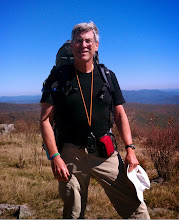You may remember a few months back when I mentioned Andrew Skurka's concept of "type one" fun while hiking, as opposed to "type two" fun. As a reminder, type one fun is fun at the time, and fun to talk about later. Type two fun is not fun at the time, but fun to talk about later. Well, my much anticipated four day trip to the Cranberry Wilderness in West Virginia (approximate location marked below) was definitely type two fun. No doubt about that.
What went wrong? Here is a major clue - when you lose five times as much body weight on a trip as the amount of weight your food bag loses, something very wrong is happening. I took lots of food and ate hardly any, and came back 80 hours after leaving home about 4.5 pounds lighter.Just getting to the trailhead was an adventure! I went with my friend Carl and his engaging daughter Libby. They picked me up Thursday morning at my home, and we were on the road to adventure! Neither Carl nor I had a West Virginia highway map (mistake number one) but he had a GPS and I had specific instructions from this Backpacker Magazine on-line article: "drive 22 miles west from Millwood, WV." The article should have said east, not west. We drove right past the road to the trail, drove 22 miles to Millwood, and went 22 miles west to end up in - a city. I found a map there and realized that we had gone right past the point, now nearly 50 miles behind us. It was a very frustrating realization. So we hit the trail very late Thursday, about 4:30, and only hiked 3 miles to a decent camping site.
Our route is shown below, each of the four days in a different color (day one - red; two - grey; three - magenta; four - yellow). Our original plans were for a 23 mile loop, following the northerly part of the trip on this map, then swinging north, not south, to pick up the Middle Fork Trail. Instead, we did a 15 mile route - out on the North Fork Trail, returning on the Forks of the Cranberry Trail. We gained about 2,900 feet on the hike, and descended about 3,600 feet. Because we ended up more than three miles south of the car, Carl provided limo service by running to the car, and driving down to pick us up.
Here is the very start of the trip Thursday, when the promise of a new hiking trip looked so bright. I had been thinking about this trip for months - to hike in the biggest wilderness area in the east, to hike in a new state for the first time. Why, for a couple of months, my work password was "cranberry!" (Don't bother trying to hack in, I've changed it to something entirely different now).
So what went wrong? Well, in a word, a tiny, invisible spec of RNA we call a virus. When we started hiking at 4:30 Thursday, I felt fine. When we made camp, I felt pretty good but not hungry, so I made a command decision to not eat the freeze dried vegan curry I had planned for my meal - a very wise choice, as it turned out. By 8:30, I wasn't feeling right at all, and went to bed. By 9:00, I had intense heartburn, despite having eaten not a thing since a Subway sandwich at lunch. By 10:00, I would be out of my tent, violently vomiting over and over, and that continued all night until just before dawn. And it picked up again Friday afternoon for a while. It was a thoroughly miserable and exhausting night and day. The first solid food that I was able to keep down in 48 hours was a bagel Saturday morning. Other than that bagel, my total food consumption for the trip was part of a Honey Stinger bar, about two tablespoons of GORP, three packets of hot chocolate, two pieces of cheese, two packets of instant breakfast, some honey in tea, and maybe 10 dried apricots and plums. That's it! Try hiking any distance on that, and you will lose weight, trust me. And you will have a hard time staying warm because you are not consuming any calories to burn. I was exhausted most of the time, and the smallest chore - like putting a sleeping bag in a stuff sack or striking the tent - was so tiring. I tried hiking Friday on a rainy day, and after only about 1.2 miles or so, I just stopped and doubled over. Carl said "We are camping here tonight!" Wise choice, because I could not have continued.
Saturday, well enough to eat that bagel, we talked and decided that instead of doubling back to the car, about four miles away, we would continue and do the loop indicated on the map above. We guessed it would be about 7 miles (it was actually about 11) and that we could be out late Saturday and end the trip a day early. As it turned out, I could not do it all in a day, even with some help from Carl, so we made a late camp Saturday night in a spruce forest on top of a mountain, and completed the trip Sunday. I cannot remember the last time I felt so ill and wiped out - maybe not since doing chemotherapy.
Well, more to come later. The trip did produce some good moments. Libby had a great time with her dad, and was totally great to get along with. She is quite the little hiker - I was pretty impressed.
Here I am at the start of the trip. It was the last time I felt good until - well, I can't tell you, because I still don't feel good two full days after getting home!


























































